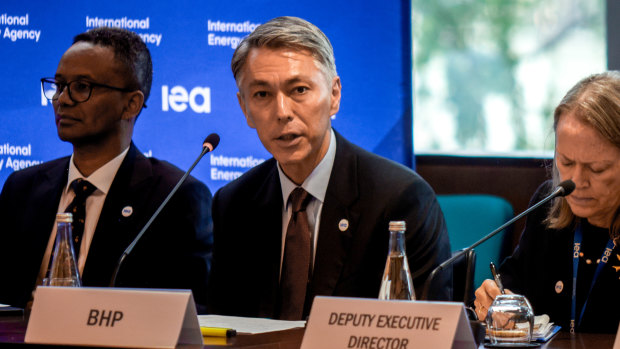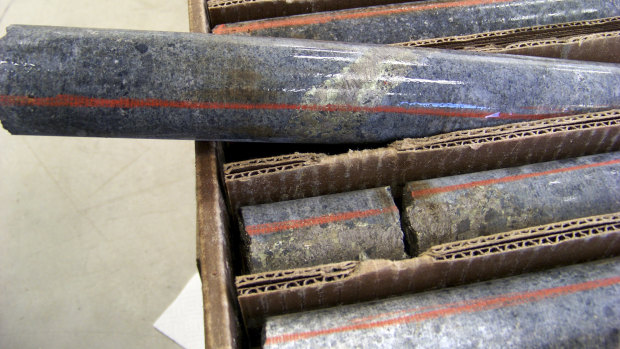Save articles for later
Add articles to your saved list and come back to them any time.
London: BHP boss Mike Henry says governments must provide stability to significantly scale up the supply of critical minerals as the energy transition gains pace.
Speaking at the International Energy Agency’s inaugural critical minerals summit in Paris, Henry called for a “small set of common standards” covering environmental, social and governance to underpin the access to capital required for investment the sector.
BHP chief executive Mike Henry addresses the inaugural IEA critical mineral summit in Paris.
Critical minerals, essential for a range of clean and renewable energy technologies, have risen up the policy and business agenda, but a combination of volatile price movements, supply chain bottlenecks and geopolitical concerns has created a potent mix of risks for secure and rapid energy transitions. This has triggered a scramble across the world to enhance the diversity and reliability of critical mineral supplies.
The head of the Australian multinational mining and metals public company, based in Melbourne, said urbanisation, industrialisation and population growth were driving demand for minerals such as copper, nickel and lithium and steel-making raw materials, along with the push to decarbonise economies.
“Governments must provide predictability and stability to attract capital at the lowest possible cost and as quickly as possible,” he said.
“This means stable fiscal settings, streamlined planning and permitting processes and harmonised standards. Too often we see short-termism in government policy, or policies which seek to meet near term political objectives, but which show limited understanding of what drives investment.”
Australia is the world’s leading producer of unprocessed lithium, the world’s third-largest cobalt exporter and the fourth-largest exporter of rare earths, which are in increased demand from Europa. Australia is also the fourth-largest exporter of mined copper and nickel and a significant producer of aluminium.
Using copper as a case study, BHP estimated that about $250-billion in growth capital to 2030, in addition to sustaining capital, was needed to support the decarbonisation needed for a “plausible 1.5 degrees scenario”.
“Currently committed growth projects over this period only amount to around $US40- or $US50-billion today. More projects need to be identified, permitted and given the green light by those who are to invest in them,” Henry said.
Minerals containing copper, nickel and precious metals.Credit: AP
Addressing the meeting in Paris included several government ministers, including US Energy Secretary Jennifer Granholm, who cautioned about the potential for critical minerals supply to be “weaponised”.
Henry called for a global convergence of ESG and governance standards.
“We need a small set of common standards, upheld by all, and where performance against those standards is a greater and increasing determinant of access to capital,” he said
Miners, Henry added, should be granted access to resources based on the value they create, including for host communities and First Nations peoples.
“Opening a mine, done well, creates sustainable wealth and jobs…But of course this must be done with least possible impact to the environment,” he said.
Granholm said the world was up against a dominant supplier of critical minerals that is willing to exploit its position for political gain – in remarks likely aimed at China – and warned that energy security will become increasingly complex due to the transition to cleaner power.
“We are up against a dominant supplier that is willing to weaponise market power for political gain,” Granholm said. “But our global energy crisis has taken on a new dimension, which is the urgency of this clean energy transition.”
IEA executive director Fatih Birol said locking in secure and sustainable supplies of critical minerals for the clean energy transition had quickly become a top priority for governments, companies and investors around the world.
“When we look at both the production and the refining, processing of the critical minerals we see a very high level of concentration,” he said in opening remarks to the conference.
“Looking at the history of energy in the last 100 years, when there was major concentration of one single country, one single company, one single route, there’s always a challenge.”
In a recent report, the IEA highlighted the concentration of supply currently, with the Democratic Republic of Congo dominating cobalt supply, China holding half of planned lithium chemical plants and Indonesia representing nearly 90 per cent of planned nickel refining facilities.
Get a note directly from our foreign correspondents on what’s making headlines around the world. Sign up for the weekly What in the World newsletter here.
Most Viewed in World
From our partners
Source: Read Full Article



